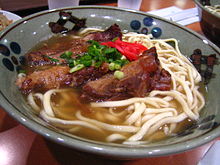- Okinawa soba
-
Okinawa soba (沖縄そば) is a type of noodle soup eaten in Okinawa. In Okinawa, it is sometimes simply called soba or suba, although it is different from buckwheat noodles known as soba in the rest of Japan. The thick wheat noodles resemble udon, while the soup is more similar to that of ramen.
The noodles tend to have a circular cross section in the Yaeyama Islands, and tend to be slightly flat in the rest of the Okinawan archipelago. It is served in a broth flavored with konbu (edible seaweed), katsuobushi flakes and pork.
Standard toppings are kamaboko (fish cake), sliced scallion and a thick slice of stewed pork belly (三枚肉 san-mai niku) or boneless pork ribs (ソーキ sōki), and usually garnished with beni shoga (pickled ginger).
For extra spice, diners can add a few drops of kōrēgūsu (高麗胡椒, コーレーグース "Korean pepper"), which consists of chile peppers soaked in awamori rice liquor.
Varieties include:
- Sōki soba (ソーキそば) - topped with extra ribs, known as sōki in Okinawan.
- Tebichi soba (てびちそば) - topped with stewed pig trotters.
History
What is now called Okinawa soba was originally brought from China some 500 years ago. Braised pork rib noodle soup is still a common street food in Zhejiang Province. Zhejiang is the closest province of mainland China to the Ryukyu Islands and was a trading hub between Japan and China in the past.
During the era of the Ryūkyū Kingdom, before Okinawa's annexation by Japan in the late 1800s, Okinawa soba could only be eaten by royalty. After Okinawa's annexation, however, during Japan's Meiji period, the prohibition was lifted, and Okinawa soba could be eaten by commoners.
Is it soba?
The word soba in Japanese means "buckwheat," but Okinawa soba noodles contain no buckwheat—they are made entirely from wheat. After Okinawa was returned to Japan in 1972, Japan's soba-growers' association tried to make Okinawa drop the name "soba," since according to regulations on the naming of noodles, a noodle must contain at least 30% buckwheat in order to bear the name "soba." In the end, the Okinawan soba makers won an exception based on the argument that "Okinawa soba" was a vital part of Okinawan culture, and that soba can occasionally mean noodles in general. (Ramen, also made from wheat flour, is sometimes called Shina Soba or Chuka Soba, both meaning "Chinese soba". Yakisoba (stir-fried Chinese noodles) also contain no buckwheat.)
Today, if one wants to eat buckwheat noodles in Okinawa, one must generally look for "Japanese soba" (日本そば nihon soba) on the menu.
Categories:
Wikimedia Foundation. 2010.

